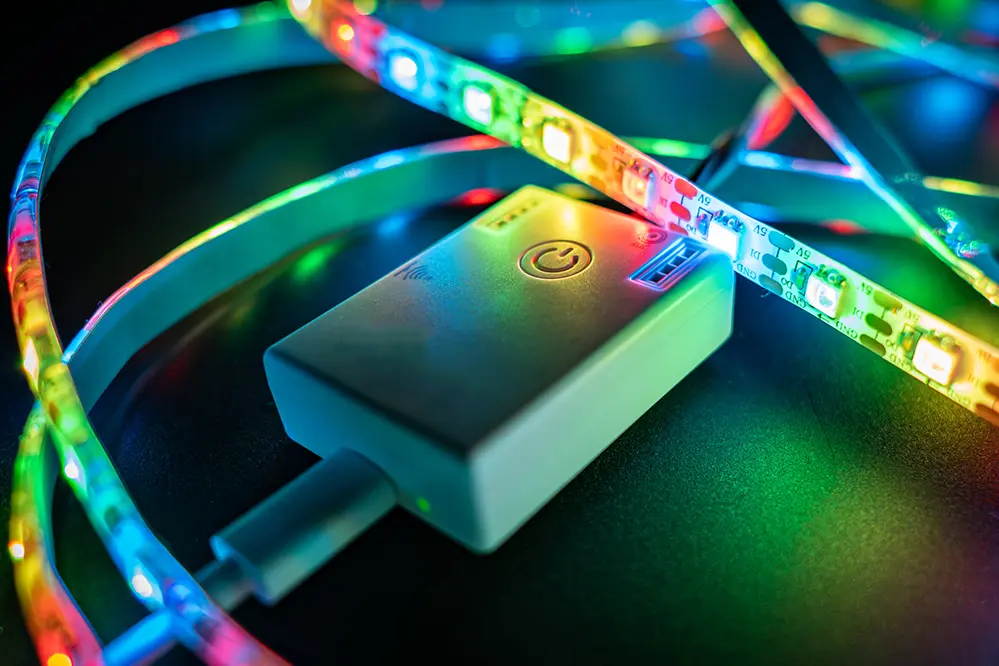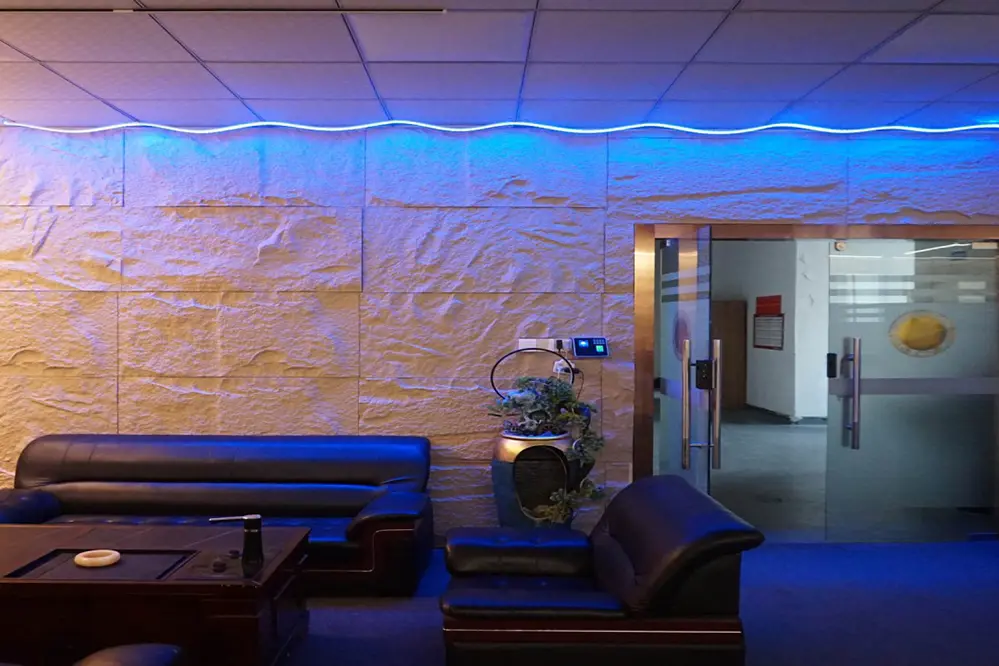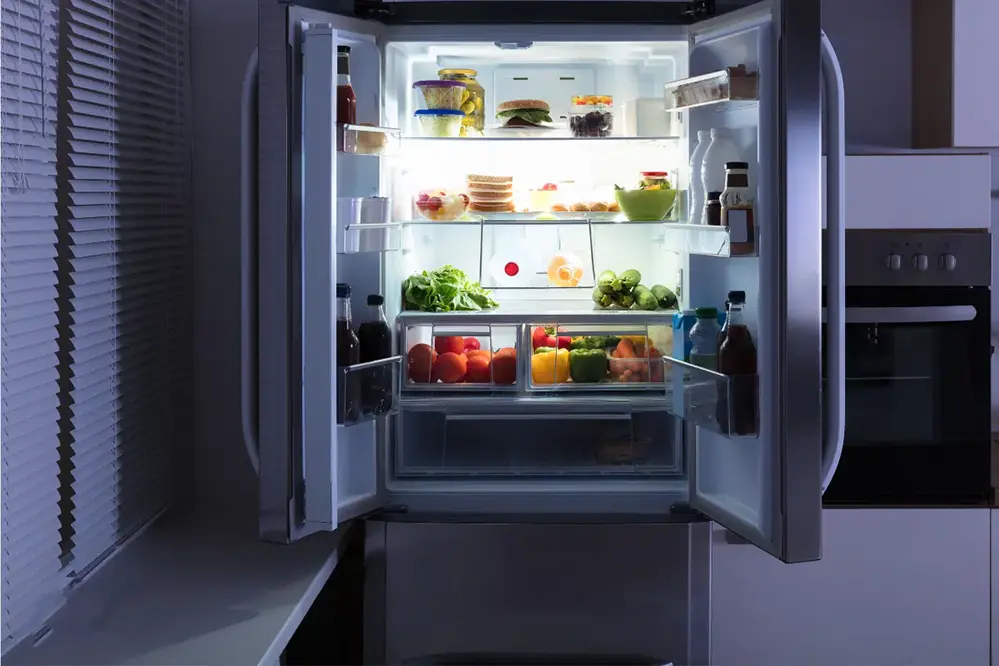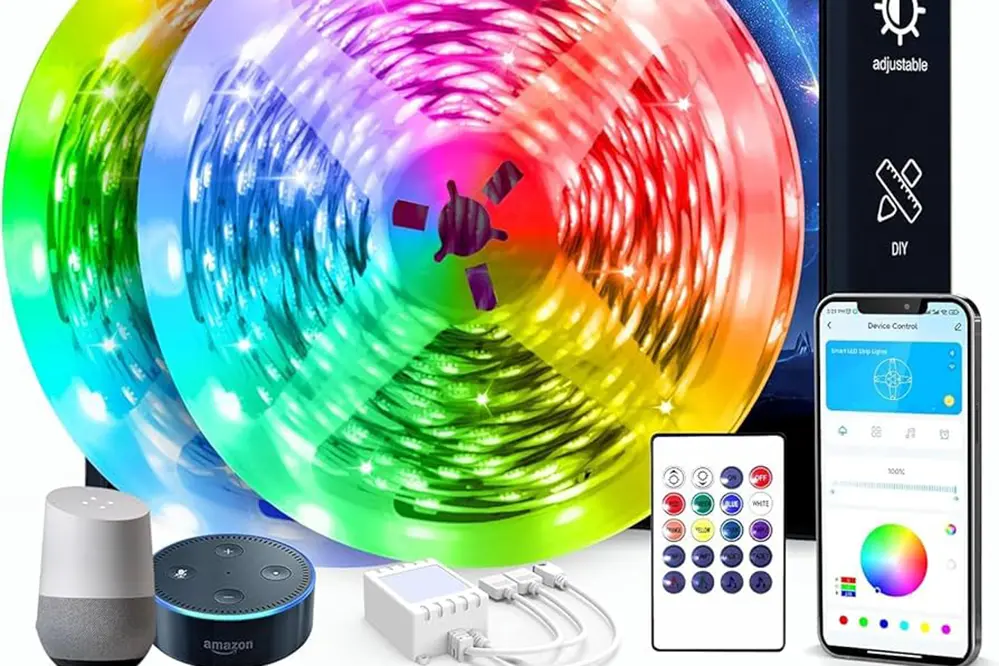Are you curious about how to power your LED strip lights? You’re in the right place. With expert insights, we’ll guide you through the essentials of powering these versatile lighting solutions.
LED strip lights do not require charging; they are powered by direct connection to an electrical source, typically through an adapter or plug-in system.
Explore the different power options available and learn how to choose the best one for your specific needs. Let’s dive into the details!
Understanding LED Strip Lights
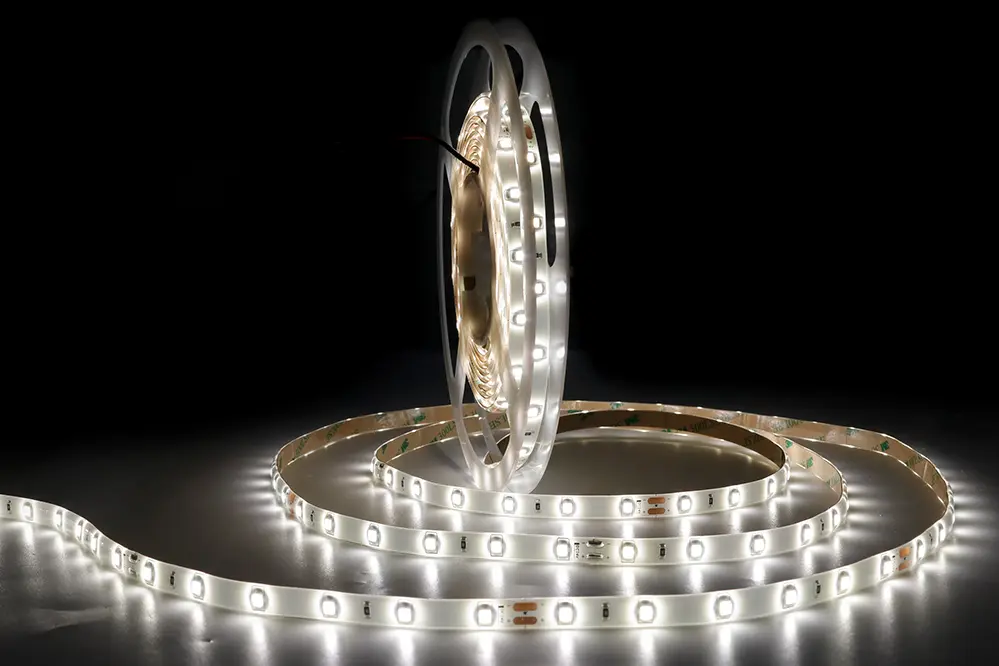
LED strip lights are a marvel of modern lighting technology, combining flexibility with impressive illumination capabilities.
These versatile, often adhesive-backed strips are a popular choice for accent lighting, setting the stage for virtually any environment with a spectrum of vibrant colors. Widely used in both residential and commercial spaces, their ability to imbue a sense of dynamism makes them a staple in designing ambient atmospheres. By leveraging light-emitting diodes (LEDs), these strips achieve high-energy efficiency while maintaining remarkable longevity, outshining traditional lighting options.
Moreover, the adaptability of these strips permits a straightforward installation process tailored to any conceivable layout. With waterproof varieties available, LED strip lights can even embrace spaces where moisture might be a concern, like bathrooms or outdoor settings, broadening their scope of use. This enhances the creative potential for lighting arrangements without being encumbered by traditional design limitations.
Technological advancements have bolstered the functionality of LED strip lights significantly. For instance, some models now come with smart-home compatibility, enabling users to control lighting through mobile apps or voice commands seamlessly. This innovation democratizes premium lighting experiences and offers individuals the opportunity to personalize settings at their fingertips, amplifying both convenience and customization possibilities.
Powering LED Strip Lights
When contemplating the illumination jewels of our modern aesthetic, we delve into the power sources that enable their brilliance.
Generally, most LED strip lights do not require charging since they are primarily designed to be connected directly to a power source. This design facilitates a continuous performance across a variety of environments, permitting an unbroken glow that enhances any space with unmatched elegance. This direct connection also provides consistent luminance without the intervals associated with recharging needs.
Intriguingly, there are also battery-operated versions on the market. These variants provide flexible placement since they do not need a constant power supply, allowing you to illuminate areas where power outlets might be unavailable or inaccessible.
When we consider the unyielding advancements in power technology, LED strip lights transform milieus by drawing from versatile energy solutions. Whether tethered to a wall socket or energized by rechargeable battery packs, they exemplify a harmonious fusion of design and engineering. This ensures that any installation can thrive with sustainability, heralding an era of inspired decor driven by innovation.
Hardwired vs Plug-in Options
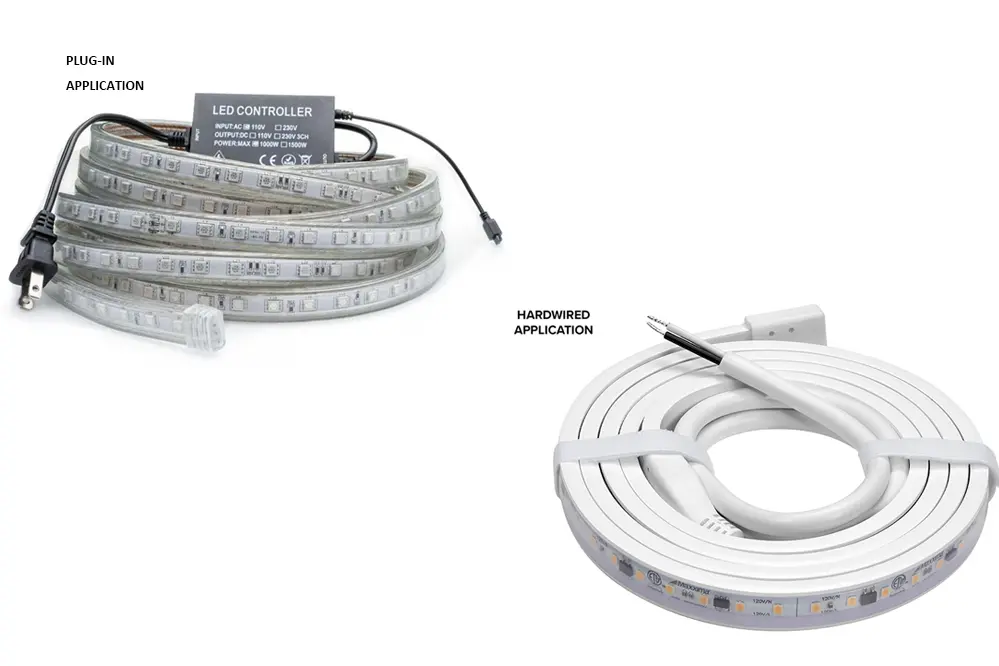
Navigating the world of LED strip lights brings us to the crossroads of hardwired and plug-in options.
In recent years, these lighting solutions have transformed from simple decor enhancements to vital components of modern design, offering unprecedented versatility and aesthetic appeal. The choice between hardwired and plug-in configurations significantly impacts both the functionality and the installation process, tailoring the user experience to fit specific needs and preferences, as well as your home’s existing electrical framework.
For those seeking a permanent and professional look, hardwired LED strip lights seamlessly integrate into existing circuitry. This option is preferred for larger installations where longevity and reliability are paramount, enabling a clean appearance free of visible wires. On the other hand, plug-in options cater to those who cherish flexibility, facilitating easy relocation and installation without the need for professional service.
It’s important to consider the demands of your space, whether you require the seamless aesthetic of hardwired installations for your kitchen counter or the portable ease of plug-in options for a dynamic bedroom setup.
Balancing these elements, LED strip lights embody the future of personal and professional environments.
Do You Need to Charge LED Strip Lights?
Wondering whether LED strip lights require charging reflects common questions about their power connection and usage, providing clarity as technology evolves.
Fortunately, the answer does not involve tedious charging rituals.
These innovative luminaires typically connect directly to a power source via a plug-in or hardwired system, ensuring uninterrupted illumination without the need for charging. This streamlines functionality, accessibility, and the operation of LED strip lights.
With the variety of power options available, choosing an LED setup need not be daunting. It opens a gateway to creativity and efficiency, fitting seamlessly within diverse settings, whether you desire a single color ambiance or a dynamic light show. By understanding these options, you gain the ability to customize and enhance your living or working space, turning vision into vibrant reality.
Battery-Powered LED Strips
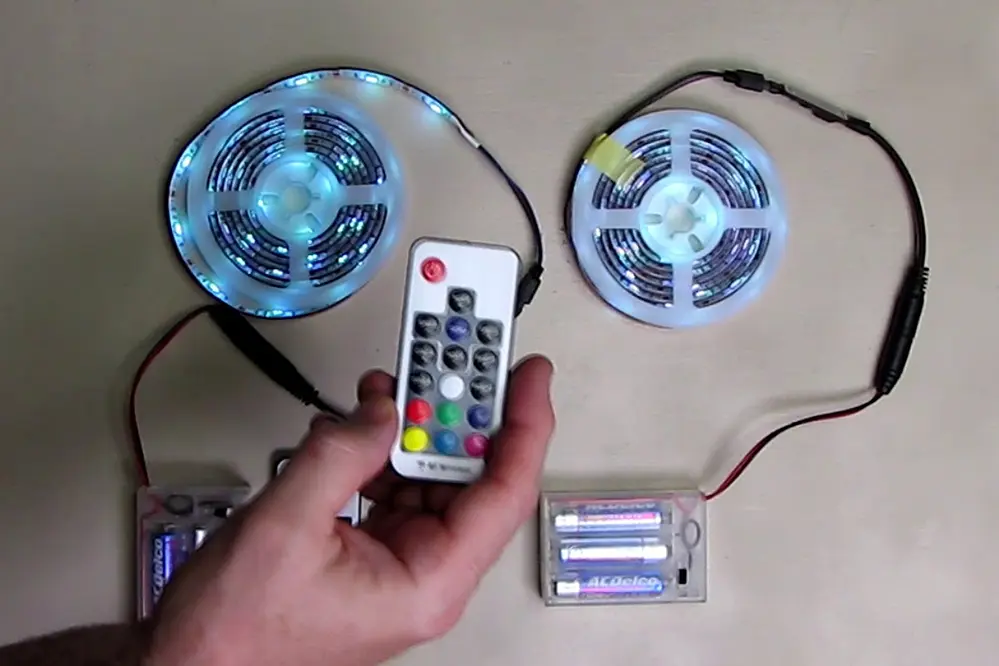
Battery-powered LED strips represent a flexible, portable solution for creative lighting endeavors, unanchored by direct power access. They bring a new dimension to versatile lighting applications.
These rechargeable strips often rely on the internal power banks that supply sustainable illumination.
Typically, users can expect a steady glow for several hours, providing reliability and ambiance.
Charging intervals depend on usage patterns and battery capacity, ensuring adaptability for various circumstances.
Fortunately, advancements in battery technology now provide extended periods of vivid lighting, allowing users to sidestep frequent charging while securing a dynamic visual experience anywhere.
Ultimately, the choice is yours: illuminate spaces without constraints or embrace the plug-and-play convenience of traditional setups. Both offer unique advantages tailored to distinct needs.
Solar-Powered LED Options
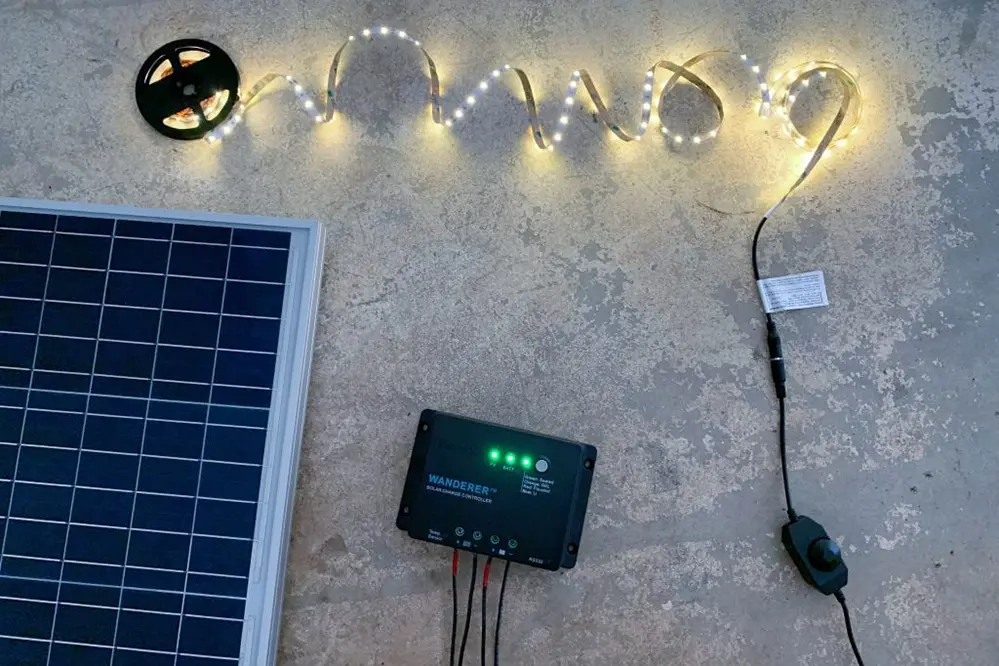
Harnessing the power of the sun, solar-powered LED strip lights are a shining beacon of sustainable lighting technology, perfectly merging innovation and environmental consciousness.
Solar strips convert sunlight into energy, storing power precisely for later use.
During installation, solar panels should be positioned for maximum sunlight exposure (optimally south-facing configurations are recommended) to harness energy effectively.
These systems stand as an epitome of eco-friendly lighting solutions by minimizing electrical consumption without sacrificing brightness and brilliance.
The efficiency of solar-powered LED strips continues to improve, promising enhanced longevity and performance, thus aligning with energy-saving goals and a greener lifestyle with every flick of the switch.
With such options, you not only reduce energy issues but actively contribute to sustainability. Future lighting solutions offer both aesthetic elegance and environmental guardianship.
Selecting the Right Power Source
When choosing LED strip lights, a myriad of powering options, each with their own merits, beckons consideration. Whether capably opting for direct electrical connections, reliable battery-driven alternatives, or the novel solar-powered choices, the right power source can make a significant impact on illumination efficacy. Evaluating factors such as installation complexity, energy efficiency, and intended use environments will inform your decision, ensuring your selection resonates with both functional needs and your vision for an illuminated future.
Indoor Solutions
Elegant indoor LED strip lights transform spaces—brightening—while seamlessly complementing your stunning interior design with flexibility and adaptability for unique lighting schemes.
Enchant your interiors with flexible LED strip lighting, adding vibrancy, mood, and captivating ambiance to any space, enhancing both functional and aesthetic brilliance.
Indoor environments offer exciting opportunities to personalize lighting experiences, and they come with specific challenges. Consider utilizing LED strips that can be paired with compatible dimmers or smart home systems, enabling tailored ambiance to match any occasion or activity.
It’s crucial to select a power option that aligns with the desired lighting effect—whether a continuous soft glow or an intense brilliance—ensuring long-term functionality. Plug-in transformers, typically employed for indoor applications, provide a reliable power source, enhancing sustainability and convenience.
Outdoor Solutions
Outdoor illumination goes beyond mere practicality, transforming spaces into stunning vistas of creativity and mood.
- Solar-Powered LED Strips: Harness sunlight effectively for sustainable, no-charge illumination.
- Battery-Operated LED Strips: Ideal for locations without power outlets, offering portability and flexibility.
- Direct-Power LED Strips: Connect directly to power sources for uninterrupted glow, perfect for patios or garden areas.
- Water-Resistant Options: Essential for all-weather durability, ensuring longevity and performance.
Integrating LED strips outdoors fosters a mesmerizing environment, seamlessly blending nature with innovative lighting.
Choose power options that align with your outdoor vision, ensuring fantastic ambiance without ongoing charging concerns.
Troubleshooting Common Issues
Experiencing flickering or inconsistent light output can often indicate connection problems or power fluctuations, but fear not, these issues are fixable.
Replacing old power adapters might resolve flickering caused by insufficient power.
Checking all connections ensures consistent current flow and safeguards against accidental disconnections. Inspect the quality of connectors and address any corrosion or wear promptly.
If your LED strip lights fail to illuminate, it could signify a variety of subtle issues, from a potential polarity mismatch to an overlooked setting adjustment in the controller. Always ensure the power supply aligns with the voltage requirements and conduct regular maintenance to prevent future setbacks. By tackling these troubleshooting steps, you’ll not only restore functionality but enhance the longevity of your lighting system.
FAQs
Do LED light strips need to be charged?
LED strip lights are generally not charged because they are primarily designed to be powered directly through a connection to a power source. These innovative lighting solutions are a testament to how advancements in technology can seamlessly blend functionality with aesthetic appeal.
Functioning through a simple plug-and-play system or a connection to a power adapter, these lights revolutionize the way spaces can be lit up, bringing vibrant illumination to homes and venues without the hassle of complex installations. Their incredible versatility allows users to customize and control their lighting environment with ease.
Some models offer additional features such as smart connectivity, enabling users to adjust colors, brightness, and even incorporate them into smart home ecosystems. This level of convenience and customization underscores their popularity and growing ubiquity in contemporary lighting design across various settings.
Battery-operated strips do exist and need recharging, but they differ from standard models. Nevertheless, both types of LED strip lights are noteworthy for their energy efficiency and longevity, making them a sustainable choice for environmentally conscious consumers.
Overall, the innovative power delivery options available for LED strips ensure that illuminating your world is both accessible and efficient.
Do LED strip lights run out of battery?
LED strip lights, known for their vibrant energy and incredible versatility, operate wonderfully off a consistent power source but not from a battery alone. They adhere to plug-in or mounted setups that require electricity, or portable battery packs to maintain their charming glow.
Certain models are powered by batteries, ensuring compatibility with your specific needs.
Investing in LED strip lights that utilize battery packs offers an alternative for flexibility, useful for areas where there isn’t a convenient outlet. These battery-powered LEDs won’t technically ‘run out of battery’ if you have charged backups or use rechargeables.
Whether you’re enhancing your living space with a lively ambiance or illuminating your creative projects, LED strip lights deliver consistent brilliance. By opting for rechargeable options, you can reduce waste, ensuring they remain an environmentally-friendly choice. Remember that their lifespan largely depends on the efficient management of power sources, mostly electricity or rechargeable options. Wave goodbye to monotony while transforming spaces into illuminating spectacles, knowing these lights work reliably when well-connected to their needed power supply.
Do LED lights need charging?
In today’s rapidly advancing technological era, LED lighting has emerged as a beacon of energy efficiency and modernization. These luminescent diodes offer a practical and energy-conserving solution to traditional lighting methods.
While standard LED strip lights are generally connected directly to a power source, certain variations are specifically designed to be portable, running on rechargeable batteries. This allows them to be utilized in areas without immediate access to power.
Battery-operated LED strip lights harness a unique advantage, offering versatility for creative applications. With the advent of these rechargeable products, users can now enjoy the vibrant illumination of LED technology in both conventional and unconventional locations.
It is essential that we embrace the dynamic nature of innovation that LED technology represents. The fusion of flexibility with cutting-edge illumination demonstrates a promising crossroads where design meets functionality.
Whether plugging into a power outlet or relying on rechargeable options, LED strip lights illuminate the path towards a more sustainable future.
Do all LED strips need to be plugged in?
LED strips require a power source.
While some might imagine LED strips operating like cordless gadgets, they are not typically battery-operated for routine installation. The majority of LED strips are designed to be connected to an electrical source, ensuring a consistent and vibrant illumination. This is particularly advantageous for a wide range of creative and functional uses where continuous power is essential.
Wireless options are less common.
For installations favoring flexibility, portable battery packs cater to temporary setups. These are particularly useful for short-term events or spaces lacking easy access to outlets. However, most LED strips are engineered to be plugged into a fixed power source, leveraging efficiency and performance.
Innovative wireless technologies do exist.
New developments are emerging, allowing integration with smart home systems. These advances hint at a future where connectivity and control merge seamlessly with wire-free designs. Thus, the industry is on the verge of exciting possibilities that balance freedom and functionality.
Indeed, the method of power supply plays a pivotal role in ensuring the enduring allure and efficiency of LED strips. As technology evolves, so too do our options, promising ever more creative lighting solutions that cater to diverse needs and aesthetic preferences, leaving us eagerly anticipating the innovations that lie ahead.
Do LED strip lights require charging?
LED strip lights, celebrated for their energy efficiency and versatility, typically do not require charging.
These illuminating wonders are usually powered directly from an electrical outlet using an adapter. This connection provides a continuous power supply, allowing for consistent brightness and extending the lifespan of the lights. For those seeking a seamless integration, there are options for wired installations that can be elegantly concealed, promoting both aesthetics and functionality.
Interestingly, for situations where portability is key, battery-powered LED strip lights offer a practical alternative. These versions, indeed requiring charging, are ideal for temporary setups or locations without immediate electrical access. They deliver the same vibrant glow with the added flexibility of placement.
Ultimately, your choice between hardwired and battery-powered models should align with your specific lighting needs. The adaptability of LED strip lights ensures that both options cater impressively to diverse environments, whether enhancing home decor or adding flair to outdoor events. With each option, innovation continues to drive possibilities, brightening spaces with eco-conscious elegance.
Conclusion
LED strip lights present transformative possibilities, designed for simplicity and efficiency. Unlike devices that require frequent charging, these lights are typically powered directly from electrical outlets. This allows for seamless integration into any environment, ensuring consistent and reliable lighting.
With their versatile design and power connectivity, LED strip lights meet both aesthetic and functional demands. The direct plug-in models eliminate the need for ongoing charges, offering energy-efficient convenience and sustained performance. This makes them an ideal choice for those seeking reliable lighting solutions.
Embracing this technology enhances the lighting experience by championing efficiency and creativity. By focusing on LED strip lights with permanent power sources, users can craft personalized atmospheric effects without interruptions. In this evolving landscape, lighting solutions that favor enduring connections truly illuminate our spaces.
